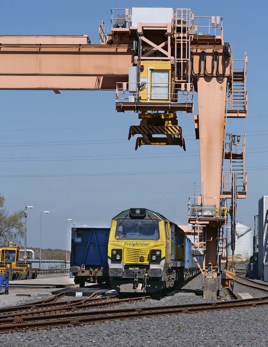Another imminent contribution to carbon reduction is the revival of high-speed freight/parcels traffic by Orion and Varamis Rail. Success in this competitive market by exploiting rail’s speed and reliability could be quickly scaled up, thanks to the relatively simple conversion of available ex-passenger EMUs to cater for roll cages and pallets.
The sparks effect
This term has been applied to the increases in passenger numbers generated by electric trains. But the impact of electric haulage on freight is just as significant, if different in character.
Wires create multiple wins. Besides decarbonising, it is the most effective and cost-efficient way to increase network capacity while also reducing operating and maintenance costs.
Electrification in Scotland could be encouraged by the HLOS requirement to “increase the average speed of freight trains by not less than 10% through good operational practices, including timetabling exercises and programmes”.
The NIC’s Better Delivery report agrees. Besides exposing the impracticalities of e-motorways, the report concludes that “considering the potential wider costs involved in other methods of decarbonising rail freight, electrification could turn out to be cheaper and quicker, improving network efficiency and providing wider benefits for passenger services”.
Bill Reeve argues: “Electrification allows you to derive enough power for heavy trains to run fast on a high-performing network, which means that on a mixed-traffic railway you can run more trains on the existing infrastructure. This saves investment in loops and all the drawbacks of slowing down, idling in a loop and restarting. By reducing the speed disparity between types of train, wiring helps timetable flighting and delivers capacity.
“The capacity benefits are also true of a single-line railway. On the Highland Main Line, the balancing speed of a reasonable-length intermodal with a Class 66 on key gradients is about 18mph, despite the relatively light weight of most boxes. It takes a long time to clear a single-line section.”
Although infill schemes top the wish list for electrification, there is no point in wires without adequate current, so power supply has to go hand in hand. The most egregious case is the number of freight and passenger trains that cannot use electric traction under the wires north of York for want of power.
Richard Moody sees the prime infill candidates as: Felixstowe-Ipswich; the Tilbury Loop to London Gateway; Acton Bank; the 18 miles from Hare Park Junction to Stourton Freightliner Terminal; Birmingham to Nuneaton for Hams Hall off the West Coast Main Line; and wiring reception roads at Trafford Park to allow through running. NR is quantifying the carbon benefits of the schemes.
Judiciously chosen infill schemes could allow another 50 to 60 freight trains a day to switch to electric haulage, which leads to the question of locomotive and wagon availability.
Julian Worth sees the return to service of locomotives in warm storage: “Principally Class 90s and ‘92s’ but also ‘91s’ - they were provided with a cab at the blunt end because they were intended to do Freightliner container trains on the East Coast Main Line at night. They could be re-geared to improve freight capability.
“The big win with wagons is the W9 gauge enhancements needed to allow the large megafret fleet to work on a route with high-cube containers. We need only W8 clearance for very low-floor wagons on routes that can’t justify more. With gauge clearance on routes such as the Great Western Main Line, we can look forward to a cascade of small-wheeled wagons for new services on lower-volume axes such as the South West.”
Although gauge clearance may not be seen as a short-term win, the work required on the trans-Pennine route is limited to Stalybridge, Scouts and Catherine Street tunnels, and three or four minor bridges which will have to be rebuilt anyway for electrification. That work has the potential to allow 15 freight trains a day in each direction, taking more than 1,000 lorries a day off the heavily congested M62/M60.
To create confidence and unlock investment, the industry urgently needs that green light from government to start a rolling, sustainable programme of electrification.
Since infill electrification has been promised in two government reports, Maggie Simpson is confident it will be authorised. But every tonne of carbon saved this year represents 29 tonnes by 2050. There’s no time like the present when it comes to the climate crisis.











